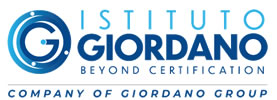LABINSIGHT: getting to know the Fire Reaction Laboratory
(Pubbl. 09/11/2022)Hello, I am Giombattista Traina, Director of the Fire Reaction Section of Istituto Giordano.
Operational since the early 1990s, the area tests the behaviour of products and materials mainly for the building and transport sector but also carries out tests in the naval and electrical sectors.

First, a distinction must be made between Reaction and Fire Resistance.
Fire Reaction tests the conduct of products and materials in the early phase of a fire, while Fire Resistance deals with the behaviour of partitioning elements in the late stage of a fire.
For the reaction to fire of construction products, we speak of classes A1, A2s1d0, up to class E or F, or class 1, if Italian methods are used. For fire resistance, we speak of REI, EI and similar classes.
Which products do you test?
The laboratory space at the Gatteo site allows us to test products of all sizes for various national, European and international test methods. In particular, we check the following:
What are the primary authorisations and notifications held by the laboratory?
The workshop is:
Let us go into more detail. Which tests do you perform, and on which products?
For the civil/building sector, products can be tested using Italian or European methods, while European or international methods are always used for other sectors.
From mid-2022, in Italy, it is no longer possible to assign the Italian class to construction products and the famous fire reaction class 1 (UNI 9177) is only used for curtains and technical installations such as photovoltaic panels.
The primary regulatory standards applicable in this area are:
For European classes A1, to be assigned to non-combustible products, up to class E or F for highly flammable products, the following tests apply instead:
As far as transport is concerned, Istituto Giordano has invested heavily in recent years to renew its equipment fleet to test materials that go into trains, to be classified with EN 45545, and into ships to be certified MED, with FTP CODE 2010 tests.
The primary testing standards used in this area are:
The laboratory then performs a whole series of other tests for the electrical sector, with needle flame, Glow wire test, UL 94 and the characterisation of upholstered products, such as sofas and mattresses, according to the primary national and international standards, UNI 9175, EN 1021-1 and 2 EN 597-1 and 2 and more.

The team consists of qualified technicians who are always up-to-date with developments in the industry. In addition, the laboratory actively participates in the work of European and national standardisation groups, including EGOLF, CEN/TC 127, SH02 - GNB, and UNI/CT 011/GL 01.

For more information on the tests visit the page
Operational since the early 1990s, the area tests the behaviour of products and materials mainly for the building and transport sector but also carries out tests in the naval and electrical sectors.

First, a distinction must be made between Reaction and Fire Resistance.
Fire Reaction tests the conduct of products and materials in the early phase of a fire, while Fire Resistance deals with the behaviour of partitioning elements in the late stage of a fire.
For the reaction to fire of construction products, we speak of classes A1, A2s1d0, up to class E or F, or class 1, if Italian methods are used. For fire resistance, we speak of REI, EI and similar classes.
Which products do you test?
The laboratory space at the Gatteo site allows us to test products of all sizes for various national, European and international test methods. In particular, we check the following:
- Building products
- Building Products for Certification in the Middle East
- Building products and furniture
- Shipbuilding products
- Train, car and bus construction products
What are the primary authorisations and notifications held by the laboratory?
The workshop is:
- notified for construction products under Regulation (EU) 305/2011 (CPR) No 0407;
- authorised to issue test certificates in the field of reaction to fire according to the specifications contained in Ministerial Decree 26/06/1984 and Ministerial Decree 26/03/1985 with alphanumeric identification code RN01RF01;
- ACCREDIA accredited no. 0021 L;
- approved as fire test laboratories by the United Arab Emirates Ministry of Interior Civil Protection (15/12/2015);
- a laboratory approved by CERTIFER to carry out tests in the railway area according to EN 45545-2.
.jpg) |
 |
|
| Fig.1 Roof fires CEN TS 1187 T2 | Fig. 2 UNI 9174 test | Fig.3 SBI EN13823 |
Let us go into more detail. Which tests do you perform, and on which products?
For the civil/building sector, products can be tested using Italian or European methods, while European or international methods are always used for other sectors.
From mid-2022, in Italy, it is no longer possible to assign the Italian class to construction products and the famous fire reaction class 1 (UNI 9177) is only used for curtains and technical installations such as photovoltaic panels.
The primary regulatory standards applicable in this area are:
- UNI 8456 Combustible products susceptible to being exposed to flame on both sides - Reaction to fire by application of a small flame
- UNI 9174 Reaction to fire of products subjected to the action of an ignition flame in the presence of radiant heat.
For European classes A1, to be assigned to non-combustible products, up to class E or F for highly flammable products, the following tests apply instead:
- EN ISO 1182 Reaction-to-fire testing of products - non-combustibility
- EN ISO 1716 Reaction-to-fire testing of products - determination of gross calorific value
- EN ISO 11925-2 Reaction-to-fire testing - Ignitability of products subjected to direct flame attack - Part 2: Testing with a single flame
- EN 13823 Reaction-to-fire testing of construction products - Construction products excluding floors exposed to the thermal attack by a single burning object
- EN ISO 9239-1 Reaction-to-fire testing of floors - Part 1: Assessment of fire behaviour using a radiant heat source
- CEN/TS 1187 Test methods for roofs exposed to fire from outside
As far as transport is concerned, Istituto Giordano has invested heavily in recent years to renew its equipment fleet to test materials that go into trains, to be classified with EN 45545, and into ships to be certified MED, with FTP CODE 2010 tests.
The primary testing standards used in this area are:
- EN 45545-2 Railway applications - Fire protection on railway vehicles - Part 2: Requirements for fire behaviour of materials and components Annex A: Standard vandalism test for seat coverings
- ISO 5660-1 Reaction-to-fire tests - Heat release, smoke production and mass loss rate Heat release rate (cone calorimeter method) and smoke production rate (dynamic measurement)
- ISO 5658-2 Reaction to fire tests — Spread of flame — Part 2: Lateral spread on building and transport products in a vertical configuration
- EN ISO 5659-2 Plastics - Smoke generation - Part 2: Determination of optical density by a single-chamber test
- EN ISO 4589-2 Plastics - Determination of burning behaviour by oxygen index - Part 2: Ambient-temperature test
- IMO MSC 307 (88) ANNEX 1 2010 FTP code
- FMVSS 302 The Federal Motor Vehicle Safety Standard No. 302
- ISO 3795 DIR.95/28/CE Road vehicles - Determination of burning behaviour of interior materials for motor vehicles
 |
 |
 |
| Fig. 4 Fume toxicity ISO 5659 EN 17084 | Fig. 5 Calorimetric Cone ISO 5660 | Fig. 6 Panel ISO 5668 FTP CODE 1 |
The laboratory then performs a whole series of other tests for the electrical sector, with needle flame, Glow wire test, UL 94 and the characterisation of upholstered products, such as sofas and mattresses, according to the primary national and international standards, UNI 9175, EN 1021-1 and 2 EN 597-1 and 2 and more.

The team consists of qualified technicians who are always up-to-date with developments in the industry. In addition, the laboratory actively participates in the work of European and national standardisation groups, including EGOLF, CEN/TC 127, SH02 - GNB, and UNI/CT 011/GL 01.
For more information on the tests visit the page













 Do you need more information about our services?
Do you need more information about our services?